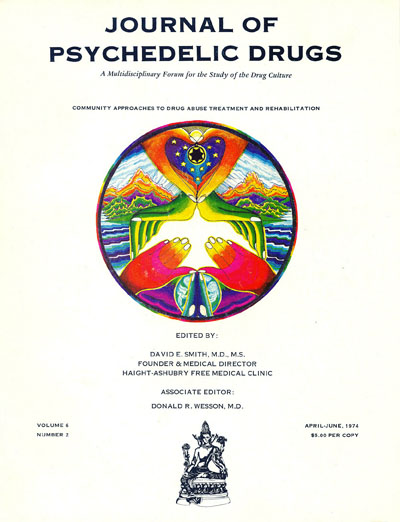Journal of
Psychoactive Drugs
A Brief History
In the summer of 1967 a new periodical appeared “to compile and
disseminate objective information relative to the various types of
drugs used in the Haight-Ashbury subculture.” Conceived and edited
by David E. Smith, M.D., the
Journal
of Psychedelic Drugs,
which began as a house organ for the Haight-Ashbury Free Medical
Clinic of San Francisco, found its geographical focus rapidly
expanding as the use of psychedelics and other psychoactive drugs
(especially LSD and marijuana) spread throughout the nation and
around the world. The
Journal's
topical focus shifted also, reflecting the replacement of the
Haight-Ashbury district’s hippie subculture and its use of
psychedelic drugs with a scene predominated by high-dose intravenous
amphetamine users, who either burned out or turned to the use of
other drugs, such as barbiturates and heroin, in an effort to
ameliorate the speedy effects of the stimulants. Similar patterns of
drug abuse began to appear in other urban centers as well. Hundreds
of free clinics, hotlines and drug information/education centers
emerged to provide this largely youthful population with
confidential, credible and nonjudgmental services, which at that
time were unavailable from traditional medical, social service, and
mental health agencies.
The directors of the Student Association for the Study of
Hallucinogens, Inc. (STASH)—a Wisconsin-based drug information
resource center—approached Dr. Smith in June of 1970 with the idea
of entering into a cooperative arrangement to publish the
Journal of Psychedelic Drugs
and to expand the periodical’s distribution. It was agreed that,
beginning with Volume 3, Number 1(September 1970), the
Journal’s
publication, subscription, and general business offices would be
moved to STASH headquarters in Beloit, Wisconsin. The editorial
responsibility for the
Journal’s
content would alternate between the Haight-Ashbury Free Medical
Clinic and STASH.
This collaboration led to the successful expansion of the
Journal
in 1974 (Volume 6) to a regular quarterly schedule and the
establishment of a professional Editorial Review Board to provide
peer assessment in the selection of articles. To mark this occasion
and to further delineate the scope of the
Journal of Psychedelic Drugs,
the subtitle “A Multidisciplinary Forum for the Study of the Drug
Culture” was adopted.
During the late 1970s the
Journal of Psychedelic Drugs
built an international reputation as a respected and authoritative
periodical. This was corroborated by the inclusion of the
Journal
in the prestigious
Index Medicus
in 1979. In 1981 the
Journal
returned to its birthplace in the Haight-Ashbury district of San
Francisco under the aegis of David E. Smith, M.D., Founder and
Medical Director of the Haight-Ashbury Free Medical Clinics, and the
continued editorship of E. Leif Zerkin, Cofounder and Codirector of
STASH. At the same time, the
Journal’s
title was changed to the
Journal of Psychoactive Drugs
to better reflect the broad scope of its contents. In 1982, Jeffrey
H. Novey joined the editorial staff as coeditor. After a
distinguished editorial tenure of more than twenty years, Leif
Zerkin moved on to other pursuits and new challenges. In October
1991, the responsibilities of managing editor passed to Jeffrey
Novey. In December 1991, Terry Chambers joined the journal staff;
she is now managing editor. In September 1996, Jeffrey Novey left to
pursue further academic achievements and Richard B. Seymour, a
long-term contributor to the
Journal,
became managing editor; he is now an editor.
Throughout its forty year history, the
Journal of Psychoactive Drugs
has been on the leading edge of developments in the field of drug
use, abuse, and treatment. It has consistently addressed the
complex nature of substance use and abuse from a multidisciplinary
perspective and has provided in-depth examination of a host of
topics, including the disease concept of addiction, drug use and
criminality, drug use and the elderly, drug use and sexual behavior,
ethnographic drug research, the history of cocaine smoking,
therapeutic communities, hallucinogens, stimulants, depressants,
smokable drugs, drug dependence and the family, women and substance
abuse, professional treatment and the 12-Step process, chemical
dependence and AIDS, shamanism and altered states, dual diagnosis,
psychotherapy/counseling, adverse effects of tobacco smoking,
understanding and preventing relapse, substance abuse in the
workplace, drug testing, methadone maintenance treatment,
prescription drug issues, and culturally relevant substance abuse
treatment. The
Journal
continues to serve both professionals and laypersons alike as an
important multidisciplinary forum for critical thinking, analysis,
innovation, and evolutionary development in the field of drug use,
abuse, and treatment.
|
